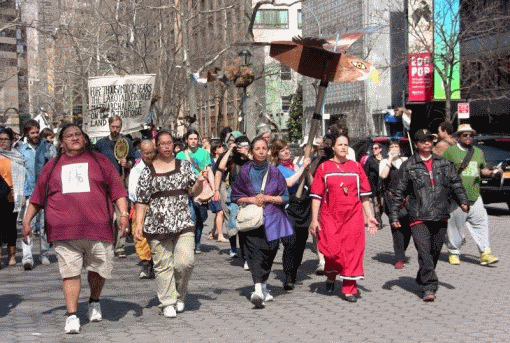NEW YORK – In April, a grassroots movement led by Lakota grandmothers toured the country to build support for a formal complaint of genocide against the United States government and its constituent states. Though temporarily overturned, the recent conviction of Efrain Rios Montt for genocide against indigenous Guatemalans should give US officials, particularly members of the Supreme Court, pause before dismissing the UN petition as a feeble symbolic gesture.
The tribal elders’ 12 city speaking tour culminated in an April 9 march on United Nations headquarters in New York and an April 18 press conference in Washington where the Supreme Court had just heard arguments in a challenge to the landmark 1978 Indian Child Welfare Act. Attracting support from Occupy Wall Street and other non-Native allies in the New York march, the Lakota Truth Tour delegation was physically blocked by UN security officers from presenting Secretary-General Ban Ki-Moon’s office a notice of charges against the U.S. under the 1948 Convention on the Prevention and Punishment of the Crime of Genocide.
 An excerpt from the complaint, still being refined into its final, legal form, reads: “This letter serves notice as complaint, that the crime of genocide is being committed, in an ongoing manner, against the matriarchal Tetuwan Lakota Oyate of the Oceti Sakowin, an Indigenous First Nation people whose ancestral lands comprise a large area of the Northern Great Plains of Turtle Island, the continent known as North America.” As evidence, the Lakota cite systematic American usurpation of their land and sovereignty rights, imposition of third world living conditions on the majority of Lakota, US assimilation policies that threaten the future of their language, culture and identity, and environmental depredations including abandoned open uranium mines and the proposed Keystone XL Pipeline slated to invade the Pine Ridge Reservation. The Lakota grandmothers and their allies in the Lakota Solidarity Project have even produced a powerful, full-length documentary, Red Cry, available on DVD or online at www.lakotagrandmothers.org »
An excerpt from the complaint, still being refined into its final, legal form, reads: “This letter serves notice as complaint, that the crime of genocide is being committed, in an ongoing manner, against the matriarchal Tetuwan Lakota Oyate of the Oceti Sakowin, an Indigenous First Nation people whose ancestral lands comprise a large area of the Northern Great Plains of Turtle Island, the continent known as North America.” As evidence, the Lakota cite systematic American usurpation of their land and sovereignty rights, imposition of third world living conditions on the majority of Lakota, US assimilation policies that threaten the future of their language, culture and identity, and environmental depredations including abandoned open uranium mines and the proposed Keystone XL Pipeline slated to invade the Pine Ridge Reservation. The Lakota grandmothers and their allies in the Lakota Solidarity Project have even produced a powerful, full-length documentary, Red Cry, available on DVD or online at www.lakotagrandmothers.org »
But the UN complaint is just one facet of a multi-pronged legal, political and educational movement within the indigenous Lakota, Sioux, nation to stop the state removal of Native children from their families into white foster homes and institutions, arguably the most salient and best-documented evidence of ongoing US violation of the genocide convention. Article 2 of the convention defines acts of genocide as follows:
“…any of the following acts committed with intent to destroy, in whole or in part, a national, ethnical, racial or religious group, as such:
(a) Killing members of the group
(b) Causing serious bodily or mental harm to members of the group
(c) Deliberately inflicting on the group conditions of life calculated to bring about its physical destruction in whole or in part
(d) Imposing measures intended to prevent births within the group
(e) Forcibly transferring children of the group to another group.”
Historically, one could make a case for the applicability of most, if not all, of the above provisions to official US policies over more than two centuries. Certainly the Indian Removal Act of 1830, the Wounded Knee massacre, of which the perpetrators have yet to be stripped of their Medals of Honor, and Sand Creek slaughter perpetrated by the US military in the latter part of the 19th century, the General Allotment Act of the same time period, the Termination/Relocation policy of the 1950s, the FBI’s war on the American Indian Movement, and the cumulative legal decisions validating the above on explicit or implicit grounds of racial or cultural superiority, come to mind as constituting violations of contemporary international standards of crimes against humanity, if not genocide per se.
Indeed, the ink was scarcely dry on the Genocide Convention before the US deliberately set out to violate Article 2(e) by arbitrarily removing Native children from their families as part of a comprehensive strategy of abolishing reservation boundaries and absorbing indigenous peoples into the states that surround and besiege them. In 1950 President Truman appointed Dillon S. Meyer, fresh from his experience administering the Japanese internment camps with an iron fist, as Indian Commissioner to carry out the final solution to the Indian Problem, i.e., their stubborn refusal to fade into the mists of history, itself a genocidal concept, that has haunted this nation since its inception. It was the formal policy and procedure of the United States at the time to forcibly transfer indigenous children to white homes and boarding schools as a component of a strategy to “terminate” tribes as distinct peoples, meeting the essential threshold of intent under the Genocide Convention. It would have been embarrassing to say the least if the Soviet Union or its allies would have initiated legal genocide charges against the self-avowed fount of human liberty at the United Nations. So it was that the US celebrated its victory over genocidal Nazi imperialism by rebranding the practice in Indian Country as emancipatory individualism and refusing to ratify the 1948 convention until nearly 40 years later.
Ironically, it was the Indian Child Welfare Act of 1978 that enabled the US to ratify the Genocide Convention by manifesting its intention to stop the wholesale removal of Native children from their families and tribes. ICWA established minimal protections of due-process rights for indigenous parents and recognized the exclusive jurisdiction of existing tribal courts to adjudicate child welfare cases within reservation boundaries, also allowing tribes to intervene in state cases. Ratified by the US in 1986, the Genocide Convention was not implemented until 1989, and then only after denying universal jurisdiction and limiting prosecutions under the act to a five year statute of limitations for violations of the federal crime of genocide. As a measure of the government’s commitment to punishing the ultimate international crime, the federal offenses of arson, art theft, immigration violation and some crimes against financial institutions all carry a statute of limitations period longer than five years. Rios Montt himself would be immune from prosecution under the federal genocide act.
A remarkable 2011 National Public Radio series, Native Foster Care: Lost Children, Shattered Families, revealed that the federal government not only fails to enforce the baseline standards of ICWA against the states. but actually underwrites the removal of Native children in some cases with additional funds, adding an economic incentive to the racial and cultural ones.
Focusing on South Dakota, a yearlong investigation by NPR reporters Laura Sullivan and Amy Walters found that 90% of the 700 Native children taken from their homes yearly in that state were placed in white foster homes or group homes, in blatant violation of ICWA provisions mandating that any Indian child taken into foster care be placed with a family member, tribal member, or other Native family in the absence of “good cause” to the contrary.
1 | 2 next page »





